Physical Address
304 North Cardinal St.
Dorchester Center, MA 02124
The histologic interpretation of pigmented lesions represents one of the most common and at times most difficult challenges in dermatopathology. This chapter introduces readers to basic aspects in the histologic diagnosis of melanocytic lesions.
The solar lentigo is a usually circumscribed pigmented macule ranging in color from tan to dark brown. It typically occurs on sun-exposed skin of older individuals ( Fig. 12-1, A ). In contrast to freckles, solar lentigines persist in the absence of sunlight. Solar lentigines are often multiple. They may become confluent and large and clinically simulate a lentigo maligna.
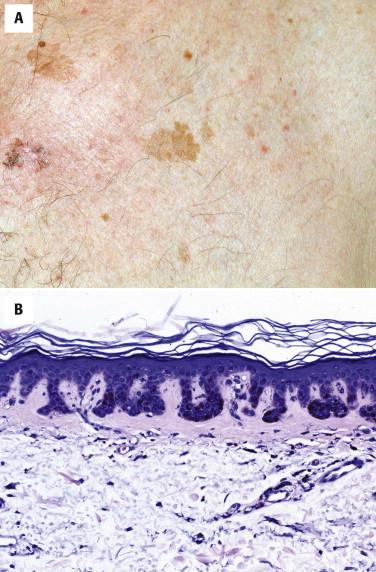
The solar lentigo is characterized by hypermelanization of basilar keratinocytes. Pigmentation is most pronounced at the tips of often elongated, club-shaped rete ridges ( Fig. 12-1, B ). The density of junctional melanocytes is within normal limits but may be slightly increased in chronically sun-damaged skin. The stratum corneum may be normal or thickened. On occasion, particularly on the face, epidermal rete ridges may be short or effaced. Solar lentigines may be associated with a lymphocytic, often lichenoid inflammatory reaction, with scattered Civatte bodies or melanophages in the superficial dermis.
The most important distinction is between solar lentigo and lentigo maligna (melanoma in situ). However, solar lentigo also needs to be distinguished from benign melanocytic proliferations and miscellaneous pigmented epithelial lesions (macular seborrheic, lichen planus–like keratosis, or pigmented actinic keratosis). Seborrheic keratosis differs from solar lentigo by epidermal hyperplasia and hyperkeratosis. The lichenoid inflammatory reaction is more pronounced in a lichenoid keratosis. Solar lentigo differs from actinic keratosis by the lack of basilar keratinocyte atypia (e.g., hyperchromatic nuclei).
Benign melanocytic proliferations that may be confused with a solar lentigo include lentigo simplex and paucicellular lentiginous junctional nevus (also called “jentigo”). A lentigo simplex differs from solar lentigo by a definite increase in the density of solitary units of melanocytes within the lesion. The diagnosis of a junctional nevus requires identification of a junctional nest (group of three or more melanocytes). Solar lentigo may at times be difficult to distinguish from a histologically subtle (“early”) evolving melanoma in situ of lentigo maligna type, especially if the solar lentigo occurs in the setting of background melanocyte hyperplasia of chronically sun-damaged skin. Clinical correlation (knowledge of the size and complexity of the lesion) and an adequate biopsy that permits assessment of a definite increase in melanocyte density within the lesion as compared with nonlesional background are paramount in such cases to arrive at the correct diagnosis.
Sampling errors may pose a pitfall. The clinician may have taken the biopsy from a paucicellular focus of an otherwise more cellular lesion. Furthermore, the cellular density may vary within a biopsy. Multiple levels and immunostains for melanocyte differentiation antigens may be necessary to document a subtle melanocytic proliferation, especially if the dermal-epidermal junction is blurred by a lichenoid inflammatory reaction. Knowledge of the clinical features of the lesion (size, complexity) greatly facilitates interpretation of subtle alterations.
A lentigo simplex (also called a nevoid lentigo) is a well-circumscribed pigmented macule. It is usually small (a few millimeters in diameter) and may occur anywhere on the body's surface. It is likely that some of these lesions represent the earliest stage in the evolution of lentiginous melanocytic nevi.
| Antigen | Antibody | Sensitivity (%) | Specificity (for Metastatic Melanoma) |
|---|---|---|---|
| S100 protein | Anti–S100P | >98 | Low |
| Sox10 | Anti-Sox10 | >98 | Intermediate |
| Glycoprotein 100 | HMB-45 | 75 | High |
| Melan-A/Mart-1 | A103/M2-7C10 | 80 | High |
| Tyrosinase | T311 | 80-90 | High |
| MITF | C5/D5 | 80-85 | Intermediate |
| Unknown | PNL2 | 85 | High |
| TRP-1 | TA99 (Mel-5) | 90 | High |
Pigmented lesions with a lentigo simplex–like histologic picture occurring at mucosal or paramucosal sites have also been termed labial and genital melanotic macules ( Fig. 12-2, A ). Genital lentigines are often associated with stromal melanophages. A lentigo-like lesion may be the histologic substrate of benign melanonychia striata or psoralen and ultraviolet A treatment-induced hyperpigmentation or may be seen in the epidermis overlying a dermal scar or dermatofibroma.
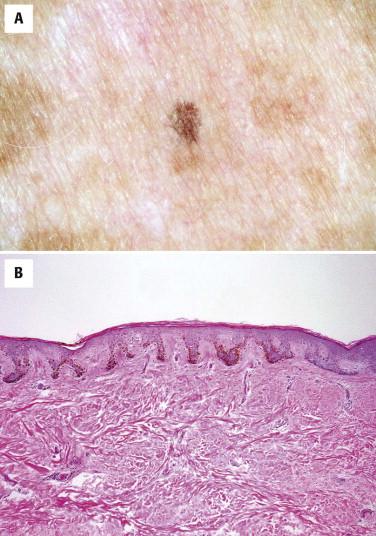
Various clinical scenarios have been described in which multiple lentigines can occur. In Carney's complex, for example, multiple lentigines and blue nevi are seen in association with melanotic schwannoma, myxomas, and endocrine disorders. Lentigines have also been described in Peutz-Jeghers syndrome, in patients with familial gastrointestinal stromal tumors, and as part of a paraneoplastic phenomenon (Peutz-Jeghers–like pigmented macules, usually in association with esophageal or intestinal adenocarcinomas).
Lentigo simplex is histologically characterized by hyperpigmentation of basilar keratinocytes as well as an increase in the density of solitary units of melanocytes at the dermal-epidermal junction confined to the clinical correlate of a small and circumscribed macule ( Fig. 12-2, B ). The melanocytes usually lack cytologic atypia. The nucleus of a melanocyte is usually smaller in diameter than the nucleus of a keratinocyte. On occasion, the melanocytes and their nuclei may be large and have an epithelioid appearance or spitzoid features (Spitzoid lentigo). The presence of enlarged cells per se, that is, without an increase in cell density, should not lead to concern about melanoma or surgical intervention. Epidermal hyperplasia with elongation of rete ridges may be an associated histologic feature of lentigines. Some lesions show marked melanin pigment deposition in keratinocytes, melanocytes, or superficial dermal macrophages and may represent a histologic correlate to what is clinically perceived as “ink spot” lentigo.
| Laugier-Hunziker syndrome | Melanonychia, mucosal and cutaneous lentigines; sporadic; not associated hamartoma or malignant tumor |
| Peutz-Jeghers syndrome |
|
| Carney complex |
|
| Leopard syndrome |
|
Lentigines need to be distinguished from solar lentigo; lentiginous nevi, including nevus spilus; but most importantly from in situ melanoma. A solar lentigo shares with a lentigo simplex the feature of hyperpigmentation of basilar keratinocytes. However, in contrast to a simple lentigo, a solar lentigo lacks an associated distinct increase in the cellular density of basilar melanocytes. Small lentiginous junctional melanocytic nevi may have only very few nests. Step sections may be necessary to reveal such nests and allow distinction of such nevi from a simple lentigo.
Hypermelanosis of basilar keratinocytes can be seen in a number of other lesions, such as Becker's nevus (hyperpigmentation associated with hypertrichosis and smooth muscle hamartoma) ( Fig. 12-3 ), melasma, the pigmented macules of Albright's syndrome (associated with fibrous dysplasia and endocrinopathy), and café-au-lait macules.
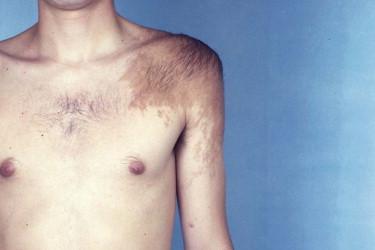
Melanocytic nevi are benign proliferations of melanocytes. Historically, they have been classified by various clinical (e.g., congenital, acquired, blue) or microanatomic (e.g., junctional, compound, dermal) attributes or by eponyms (e.g., Spitz's, Unna's, Clark's). A detailed discussion of various terms and classifications is beyond the scope of this chapter. The main issue regarding the diagnosis of melanocytic nevi is their distinction from melanoma. Recognizing variants of melanocytic nevi and familiarity with their spectrum of light microscopic appearances (e.g., pagetoid Spitz's nevus, acral nevus, recurrent nevus) serve to avoid confusion with melanoma. Recently, it has also become apparent that distinct molecular alterations are associated with different types of melanocytic nevi. The BRAFV600E mutation is frequently found in melanocytic nevi (ordinary acquired, “dysplastic,” or nevi with superficial “congenital” pattern). NRAS mutations are found in congenital nevi and HRAS mutations in sclerosing Spitz nevi and some deep penetrating nevi. GNAQ or GNA11 mutations are typically associated with blue nevi.
Age of onset: congenital or acquired
Anatomic site: acral, genital, conjunctival, other
Color: blue nevus
Microanatomic involvement
Junctional (intraepidermal only)
Compound (dermal and intraepidermal)
Dermal (intradermal only)
Cell type
Spindle and epithelioid cell nevus
Pigmented spindle cell nevus
Epithelioid cell nevus
Balloon cell nevus
Eponyms (selected examples)
Unna's nevus (ordinary melanocytic nevus)
Miescher's nevus (ordinary melanocytic nevus)
Clark's nevus (overlaps with dysplastic nevus)
Spitz's nevus (spindle and epithelioid cell nevus)
Zitelli's nevus (superficial congenital nevus)
Mark's nevus (superficial and deep congenital nevus)
Myerson's nevus (nevus with eczematous epidermal changes)
Wiesner's nevus (Spitz's nevus/tumor with loss of BAP1 nuclear labeling)
Tieche's nevus (common blue nevus)
Ota's nevus (nevus fuscoceruleus ophthalmomaxillaris)
Ito's nevus (nevus fuscoceruleus acromiodeltoideus)
Sun's nevus (nevus fuscoceruleus zygomaticus)
Melanocytic nevi tend to be symmetric and have fairly sharp borders. They may be flat ( Fig. 12-4 ) or raised ( Fig. 12-5 ). Their color may be identical to the surrounding skin or differ from it (varying from pink or red to light or dark brown).
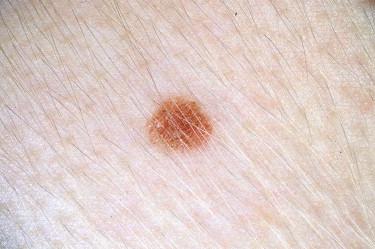
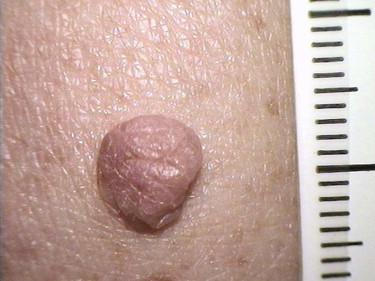
Common or ordinary nevi are symmetric and circumscribed ( Fig. 12-6 ). The melanocytes may populate the epidermis as nests only along the dermal-epidermal junction (junctional nevus) ( Fig. 12-7 ), as well as in the dermis (compound nevus) ( Fig. 12-8 ), or be confined to the dermis without involvement of the overlying epidermis (intradermal melanocytic nevus). In ordinary junctional and compound nevi, nests predominate at the dermal-epidermal junction and are preferentially positioned at or near the tips of rete ridges (see Fig. 12-7 ). Nevomelanocytes may be heavily pigmented or lack melanin granules by light microscopy. Melanocytic nevi may be associated with epidermal hyperplasia, which at times may have features of a keratosis (keratotic nevus). A melanocytic nevus may also incidentally collide with a seborrheic keratosis.
Usually small
Circumscribed and symmetric; flat or raised
Variable colors (pink, tan, brown) but usually uniform within a lesion
Usually small circumscribed and symmetric
Junctional melanocytic proliferation, if present
Predominant nested pattern, rare solitary units of melanocytes
Most melanocytic nests are at tips of rete ridges
Dermal nevus component
Evidence of maturation
Often “orderly” nested growth pattern
Often symmetric wedge or plaque-like growth pattern
Lack of marked atypia and mitoses
Possible associated features:
Epidermal hyperplasia with hyperkeratosis (keratotic nevus)
Papillomatous epidermal hyperplasia (papillomatous nevus)
Balloon cell changes (balloon cell nevus)
Inflammation and regression (e.g., halo nevus)
Fatty metaplasia of the dermal stroma
Many others (e.g., calcifications, oncocytic changes)
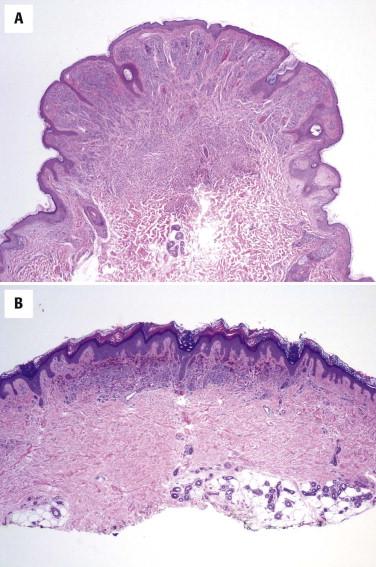
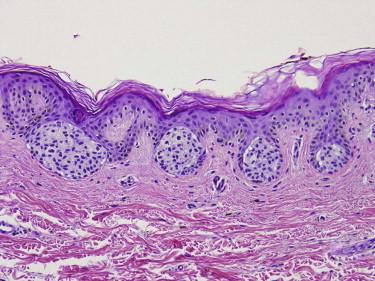

Compound and dermal nevi typically show zonation with depth (so-called maturation) in the dermis. Such maturation may be manifest at the level of individual cells. Large epithelioid (type A) melanocytes tend to dominate in the superficial dermis ( Fig. 12-9, A ). With descent into the reticular dermis, melanocytes tend to have less cytoplasm (type B cells) ( Fig. 12-9, B ) and may become fusiform (type C cells) at the base of a lesion ( Fig. 12-9, C ). Zonal changes (features of maturation) are not restricted to cell size and shape. The growth pattern of the melanocytes and their degree of pigmentation often changes with microanatomic depth. Superficially, nests tend to be larger. With descent into the reticular dermis, they usually become smaller. At times, melanocytes at the base of a nevus are dispersed as solitary units in the stroma. Intracellular melanin pigment tends to be more prominent in the superficial portion of a nevus than in its deep component ( Fig. 12-10 ). The tendency for melanin pigment synthesis to be most visible superficially but disappear in the deeper component of melanocytic nevi has also been referred to as “biochemical” maturation. Exceptions to typical zonation exist (e.g., inverted type A nevus, with large pigmented epithelioid melanocytes in the mid or deep dermis).
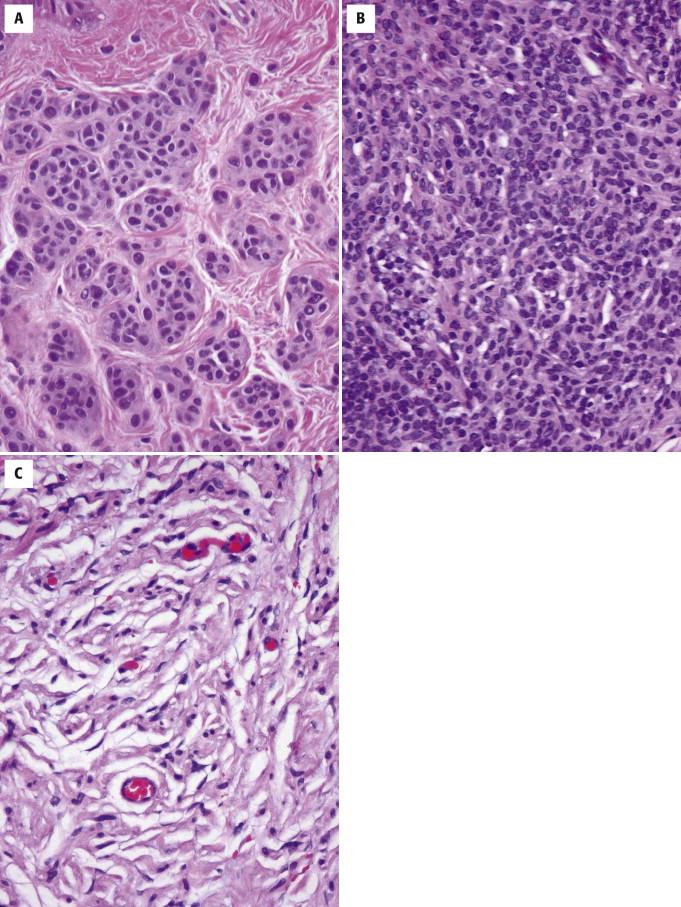
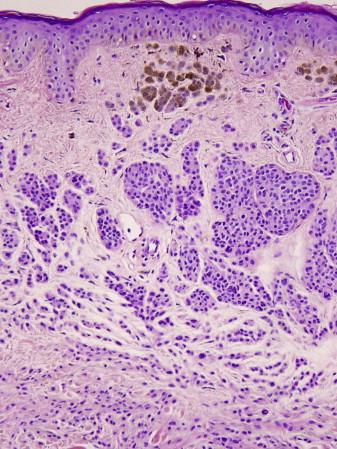
The full range of cytologic appearances from type A to type C melanocytes is seen only in a minority of nevi. Some nevi may be predominantly epithelioid in appearance; others fusiform with or without neural or schwannian differentiation (neuronevus or neurotized nevus) ( Fig. 12-11 ). Neurotized nevi may show structures reminiscent of Wagner-Meissner corpuscles.
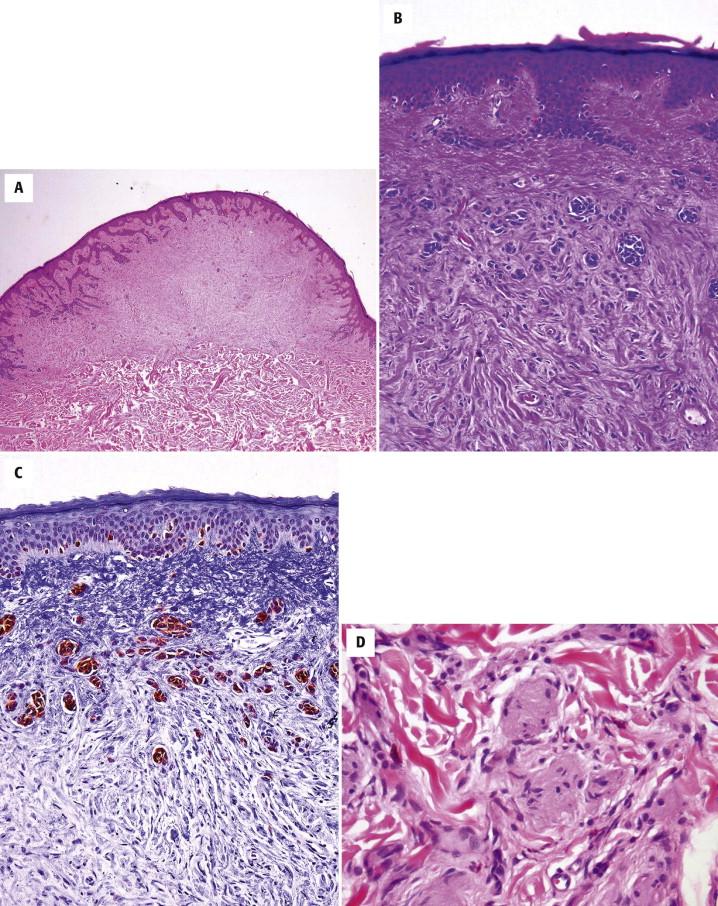
Mitoses are typically absent in common nevi. However, rare mitoses, especially in the superficial portion of a nevus, may occur. Several mitoses may be seen in benign growing nevi, especially in childhood or during pregnancy. Nevi may rarely be ulcerated. Ulceration associated with benign nevi is usually secondary to trauma or excoriation.
Some dermal nevi are inflamed or may show features of regression (loss of melanocytes associated with various stromal changes, such as edema, fibrosis, hypervascularity, presence of melanophages). Inflammation is usually sparse but may be dense. Inflammation or regression at the periphery of a nevus may lead to a clinically depigmented or erythematous rim around a pigmented center ( Fig. 12-12 ). Such nevi are referred to as “halo nevi.” A halo phenomenon may occur in other types of nevi, such as dysplastic or Spitz's nevi. Another pattern of inflammatory process that may be found in association with a melanocytic nevus is that of spongiotic dermatitis. A melanocytic nevus with features of eczema is called a Myerson's nevus.
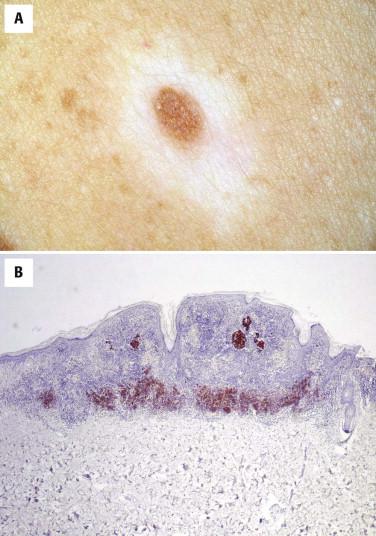
Various peculiar cytologic changes of melanocytes may occur in common as well as any other type of nevus, such as clear cell or balloon cell; oncocytic features; or prominent multinucleation, including Touton-type giant cell formation. Nevi may show fatty metaplasia ( Fig. 12-13 ) or may be associated with calcifications. In some nevi, there is prominent cellular dyscohesion leading to the formation of “pseudovascular” spaces ( Fig. 12-14 ).
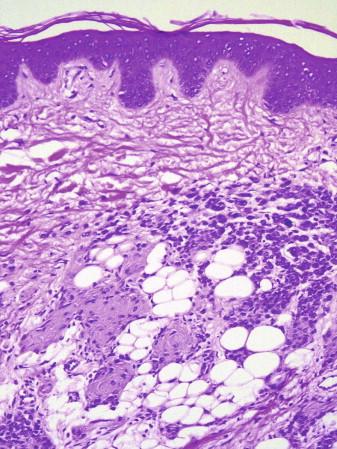
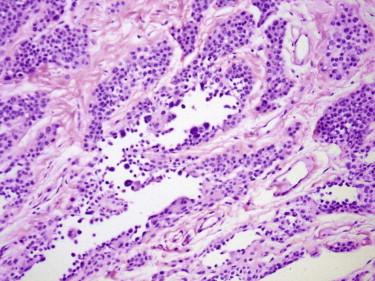
Confusion of common nevi with melanoma is rare, except for cases of so-called nevoid melanoma (see the following). Dermal melanocytic nevi, in particular on the face, may be associated with an increase in the cellular density of solitary units of melanocytes in the overlying epidermis. Such a finding may raise concern about possible in situ melanoma, especially on a small shave biopsy. If the increase in number of intraepidermal melanocytes is limited to a small area of the center of the lesion, it is in keeping with a benign nevus. If the melanocytic proliferation involves the entire tissue sample and section margins, an additional biopsy or excision may be necessary to exclude in situ melanoma. Extensive ulceration may also pose a problem because it precludes evaluation of the part of the lesion that has been removed by trauma. Several mitotic figures in dermal melanocytes underneath an ulcer should not be dismissed as reactive but should prompt further examination of a lesion for other clues that may suggest melanoma.
Amelanotic melanocytic nevi may also be confused with various benign nonmelanocytic proliferations, such as neurofibroma, cellular neurothekeoma, or histiocytoma. The latter two entities are easily distinguished from melanocytic nevi by immunohistochemistry. Cellular neurothekeomas are negative for S100 protein. Histiocytomas are negative for melanocyte differentiation markers (e.g., Melan-A, tyrosinase). The distinction of a neurofibroma from a completely neurotized neurofibroma–like nevus can be very difficult. The presence of rare epithelioid cells or small nests indicates a melanocytic nevus (see Fig. 12-11, B ). Any immunoreactivity for melanocyte differentiation markers also favors a nevus except for pigmented neurofibromas.
The concept and definition of the dysplastic melanocytic nevus (DMN; also called melanocytic nevus with architectural disorder and atypia) remain controversial. A detailed discussion of this controversy is beyond the scope of this chapter. A few comments, however, are necessary. This type of nevus was first described in context of the so-called B-K mole or atypical mole syndrome , which was later termed dysplastic nevus syndrome . The syndrome describes individuals at increased risk for melanoma with a skin phenotype characterized by the presence of numerous nevi, many of which are larger and more irregular than most ordinarily acquired nevi ( Fig. 12-15 ). It was then recognized that such nevi also occur as solitary lesions or may be present in small numbers ( Fig. 12-16 ). As such, this nevus type is a fairly common clinical finding (5% to 15% of the population). However, precise statistical data are problematic in this regard because of interobserver variation in the criteria used for classifying nevi as dysplastic or atypical.
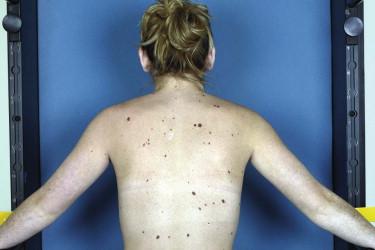
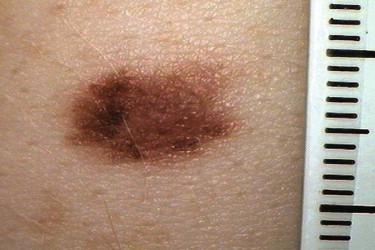
Some pathologists view the DMN not only as a marker of risk for melanoma in the context of the dysplastic nevus syndrome but also as a biologically “intermediate” lesion (manifestation of tumor progression) in the spectrum from banal nevi to melanoma.
Conflicting results and opinions about the significance of dysplastic nevi can in part be traced to variable definitions of the term. Most pathologists who use the term dysplastic nevus require both a certain set of architectural features as well as cytologic alterations for its diagnosis (see the following). Others, who tend to prefer the term Clark's nevus, pay attention primarily to architectural features. The latter approach has been criticized by advocates of the term dysplastic nevus with the argument that if cytologic atypia is not required for the diagnosis, the definition of the term becomes too broad, resulting in inclusion of many ordinary nevi, which commonly show a minor element of architectural disorder. Irrespective of the terminology, the DMN is essentially a variant of a benign acquired melanocytic nevus with features as outlined in the following.
Clinically, dysplastic nevi tend to be larger than ordinary nevi and measure usually more than 4 mm in diameter (see Figs. 12-15 and 12-16 ). They often show variation in color (mixture of tan, brown, and pink) and have a slightly irregular or “fuzzy” periphery.
Dysplastic nevi display both “architectural disorder and cytologic atypia” of melanocytes ( Fig. 12-17 ). Frequently, there are associated stromal changes. Architectural disorder refers to the deviation of the growth pattern of melanocytes from an idealized prototypical “ordinary” nevus. It includes slight asymmetry, a lentiginous proliferation of solitary units of melanocytes along and focally in between elongated rete ridges, variation in the size and placement of junctional nests with fusion or bridging of nests ( Figs. 12-17 and 12-18 ), or an irregular peripheral border, including a shoulder phenomenon (extension of the junctional melanocytic proliferation of a compound melanocytic nevus beyond the periphery of its dermal component) ( Fig. 12-19 ). Cytologic atypia refers to nuclear alterations, such as nuclear enlargement, hyperchromasia, or the presence of prominent nucleoli. Stromal changes typically associated with dysplastic nevi include lymphocytic infiltrates, hypervascularity, or fibroplasia of the superficial dermis, which often shows a lamellar pattern ( Fig. 12-20 ).
Usually larger than most ordinary nevi
Irregular borders or colors (not up to the level of melanoma)
Architectural disorder
Slight asymmetry
Slightly irregular border
Focal single cell proliferation of melanocytes along and in between rete ridges
Variation in size and shapes of nests
Bridging or fusion of nests
Shoulder phenomenon
Enlarged nuclei
Hyperchromatic nuclei
Distinct nucleoli
Lamellar fibrosis
Inflammation
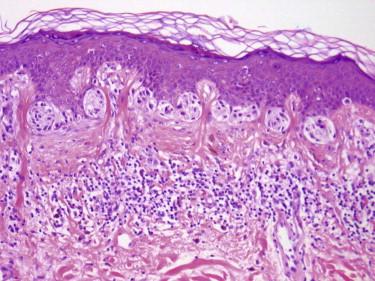
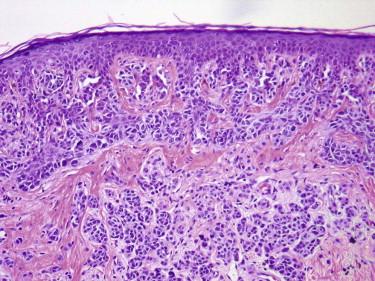
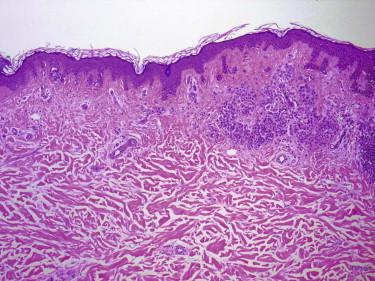
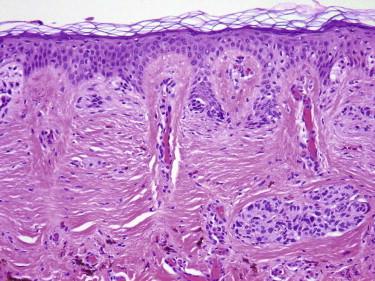
Naturally, there is a spectrum in the extent of such alterations. Some pathologists have attempted to grade the degree of cytologic atypia from mild to severe. Atypia is judged as mild if the nuclei of melanocytes are slightly hyperchromatic but overall similar in size to the nuclei of keratinocytes. A one- to twofold enlargement, often accompanied by other nuclear irregularities (irregular contours, nucleoli, hyperchromatism), is judged as moderate. A more than twofold increase in nuclear size associated with marked hyperchromatism or prominent nucleoli qualifies as severe atypia. Dysplastic nevi with moderate or severe atypia have also been referred to as high-grade lesions, but those with only slight atypia are judged as low-grade lesions.
The rationale behind grading dysplastic nevi is an attempt to separate slightly irregular but essentially banal nevi from those that might be confused with melanoma, that are possibly more likely to progress to melanoma, or that may be associated with a higher risk for melanoma. However, much of this exercise is currently still speculative, controversial, and of unproven benefit for patients. A practical value of grading a DMN may be that it confers to the dermatologist some information about the pathologist's concern about the lesion, which may influence the need for obtaining a second opinion or the decision to perform a complete excision or not. A melanocytic proliferation diagnosed as severely atypical or dysplastic by one pathologist may represent an in situ melanoma to the eye of another. A melanocytic nevus with only mild atypia is less likely to be reported as melanoma by someone else.
However, instead of using a formal grading scheme, a pathologist may prefer to express his or her concerns about a pigmented lesion to the clinician in different ways and simply state that the histologic features overlap with early melanoma and therefore recommend complete surgical excision.
The only distinction that really matters, of course, is the one between melanoma and nevus. Melanomas generally are more asymmetric and less circumscribed than dysplastic nevi. They show a more complex growth pattern along the dermal-epidermal junction with a greater distortion of the epidermis (loss of rete ridges or consumption of the epidermis). Pagetoid spread of intraepidermal melanocytes greatly facilitates the recognition of in situ melanoma. However, its presence is not entirely specific for melanoma. Focal pagetoid spread may occur in nevi, including dysplastic nevi, usually in the center of the lesion or in association with features of trauma. Prominent or chaotic pagetoid spread or pagetoid melanocytes at the periphery of a lesion indicate the presence of in situ melanoma. In contrast with the majority of melanomas, the dermal component of a DMN shows evidence of maturation.
Because the features of the DMN overlap with melanoma and melanoma may be associated with a DMN, it may not be possible on a small partial biopsy to render a definitive diagnosis because some parameters cannot be evaluated (overall symmetry, features of the borders of the lesion). In such cases, it is best to defer the final diagnosis to the review of the completely excised lesion.
Spitz's nevi preferentially affect the face and lower extremities of children and adolescents but may occur anywhere, as well as in adults. Often they appear as red, pink, or flesh-colored dome-shaped papules ( Fig. 12-21 ). Flat, pigmented, and fibrosing variants exist. Clinically, Spitz's nevi may be confused with nonmelanocytic lesions, such as angiomas, pyogenic granulomas, fibromas, warts, or adnexal tumors.
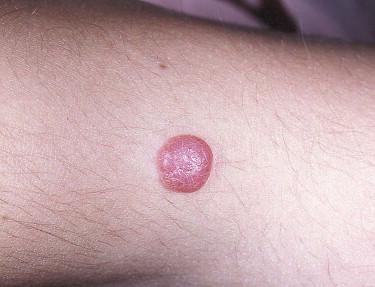
The hallmark of Spitz's nevi is their composition of large plump spindle or epithelioid melanocytes ( Fig. 12-22 ). Similar to other benign melanocytic nevi, they are typically sharply circumscribed, display a symmetric growth pattern, and show evidence of maturation. Compound and dermal Spitz's nevi are usually wedge shaped. Common associated secondary features include epidermal hyperplasia, dull pink globules (Kamino bodies) ( Fig. 12-23 ) at the dermal-epidermal junction, stromal edema, and vascular ectasia. Scattered lymphocytic aggregates may be present. There is a spectrum of cytologic features from large epithelioid to spindle cells. Some lesions are predominantly epithelioid. Others may preferentially contain spindle cells. In many junctional or compound Spitz's nevi, fascicles of spindle cells are arranged in tight fascicles parallel to epidermal rete ridges in a pattern that has been likened to hanging bananas ( Fig. 12-24 ). Junctional nests of melanocytes often show “clefts” (see Fig. 12-24 ). Mitoses may be found but are usually rare and limited to the superficial portion of densely cellular lesions.
Usually children and young adults
Typical manifestation: pink papule on face or extremities
Architecture
Symmetric (often wedge shaped)
Sharp peripheral borders
Variation in size and shape of densely cellular nests
Pagetoid melanocytes may be present focally
Large spindle and epithelioid cells with abundant pink cytoplasm
Evidence of maturation
Rare dermal mitoses are acceptable, if present in the superficial or midportion of the lesion
Secondary epidermal or stromal changes
Dull pink globules (Kamino bodies) present in many but not all cases
Vascular ectasia and edema
Patchy lymphocytic aggregates
Epidermal hyperplasia may be prominent
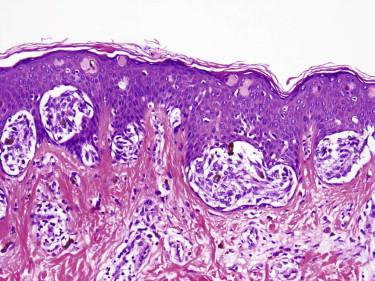
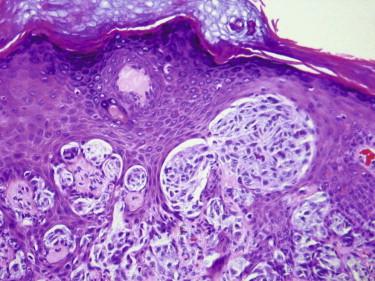
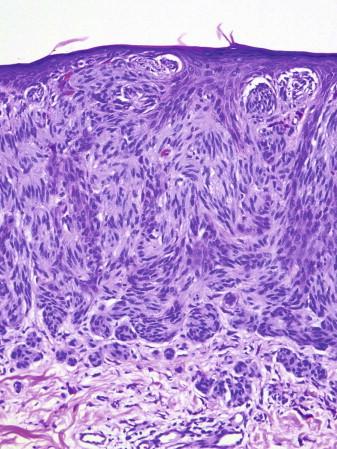
Sclerosing variants of Spitz's nevus exist. Most of them are dermal nevi, in which pleomorphic epithelioid melanocytes are dispersed as small nests, fascicles, and single cells in a densely fibrous stroma ( Fig. 12-25 ). There is often association with epidermal hyperplasia. At scanning magnification, these variants may resemble a dermatofibroma.
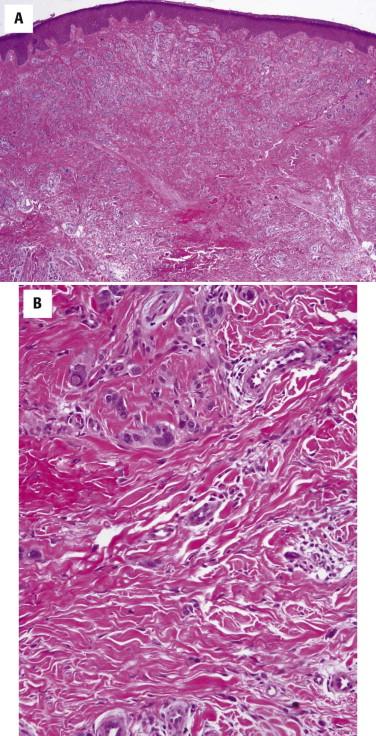
Many Spitz's nevi are amelanotic or paucimelanotic. However, heavily pigmented variants thereof exist with various proportions of spindle to epithelioid melanocytes. The so-called pigmented spindle cell nevus represents one pole of the spectrum of such pigmented nevi ( Fig. 12-26, A ). It is cytologically characterized by a predominant composition of heavily pigmented slender fusiform melanocytes ( Fig. 12-26, B and C ). The lesions are usually small, symmetric, and sharply circumscribed. There are typically densely cellular nests at the dermal-epidermal junction. The epidermal rete ridges tend to be hyperplastic. Melanin pigment is often present in the cytoplasm of keratinocytes at all layers of the epidermis, including the stratum granulosum and corneum (not to be confused with melanocytes). A few pagetoid melanocytes may be found, especially in the center of the lesion. Dull pink globules (Kamino bodies) are frequently seen. The nevi may be inflamed and associated with many melanophages in the superficial dermis.
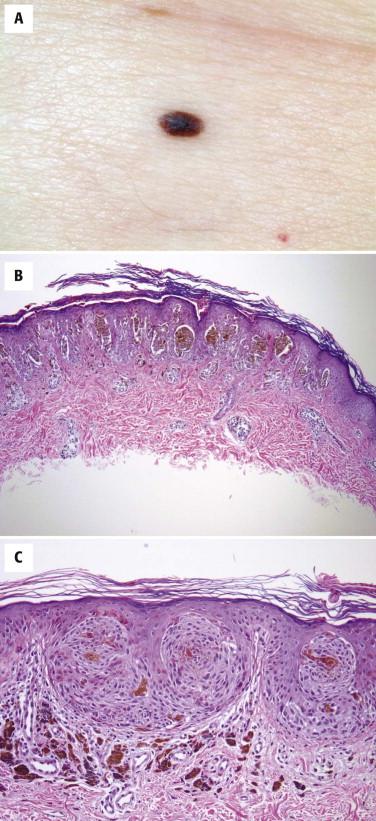
A large epithelioid cell variant of Spitz's nevus (or Spitz tumor, if accompanied by atypical features) has been described, which is characterized by loss of nuclear labeling for BAP1 (also known as “Wiesner's nevus” or “BAPoma”). The tumors commonly present as polypoid nodules composed of large epithelioid cells with round to oval nuclei and abundant cytoplasm ( Fig. 12-27 ). The nuclei have smooth contours, open chromatin pattern, and distinct nucleoli. Sparse or moderately dense lymphocytic infiltrates are common. The lesions may be associated with a conventional melanocytic nevus, thereby forming a combined nevus. The lesions carry the BRAFV600E mutation. The presence of multiple BAP1-loss Spitz nevi or tumors in a single patient may reflect a BAP1 germline mutation and in some instances be associated with a cancer syndrome. On rare occasions, melanoma may arise in association with a BAP1-loss nevus.
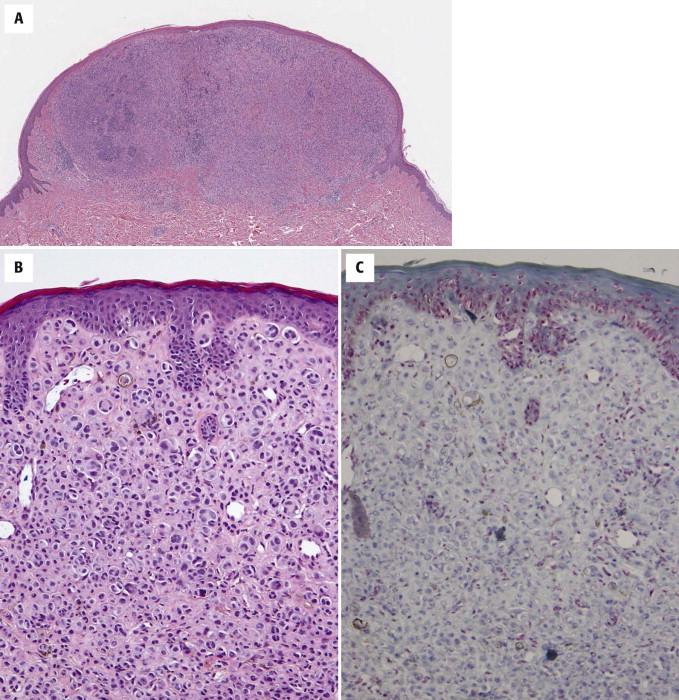
There is a body of literature on the difficulty of distinguishing atypical or unusual variants of Spitz's nevi from Spitz's nevus–like melanomas. This is reflected in diagnostic controversies; ambiguous terms, such as borderline or minimally deviant ; and misdiagnoses. For the differential diagnosis between Spitz's nevus and “spitzoid” melanoma, the following light microscopic features favor melanoma: large size, asymmetry, complex growth pattern, presence of mitotic figures in deep dermal melanocytes, atypical mitotic figures, thinned epidermis with effaced rete ridges (“consumption of the epidermis”), lack of maturation, and absence of Kamino bodies. However, none of these features is specific for melanoma. Each of them can also be seen in nevi or borderline lesions. Likewise, features more often found in Spitz's nevi than melanoma, such as Kamino bodies, may also be present in fully malignant tumors. However, melanomas tend to show only rare and small Kamino bodies. Numerous large Kamino bodies strongly favor a benign lesion.
In distinguishing a Spitz's nevus from melanoma, it is important to realize that some pagetoid spread of melanocytes is acceptable for the diagnosis of a Spitz's nevus as long as the other features of the lesion favor a benign melanocytic proliferation. Pagetoid spread of melanocytes in Spitz's nevi is usually focal, at or near the center of the lesion, and often associated with ascent of melanocytic nests rather than only solitary units. Pagetoid spread is prominent on rare occasions (pagetoid Spitz's nevus) ( Fig. 12-28 ). However, this variant is rare, and one should hesitate to make this diagnosis in an adult person unless the summary of findings (small size, sharp circumscription, good maturation of the dermal component) favors a nevus and the pagetoid spread shows some uniformity (usually limited to the lower part of the spinous cell layer, not asymmetrically localized to the edge of the lesion).
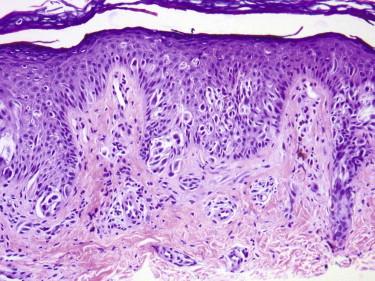
As a general rule, if a pathologist is not comfortable making a distinction between an unusual or atypical variant of Spitz's nevus and melanoma, it is best to acknowledge the diagnostic difficulty; consult with other pathologists; or use ancillary studies that may assist in the distinction of Spitz's nevus from melanoma, in particular cytogenetic analysis (see later discussion). At times, even expert consultants may also not be able to establish an unequivocal diagnosis or agree with each other. Furthermore, results from ancillary studies may not be definitive. In that case, a pragmatic decision needs to be made. Spitzoid melanocytic proliferations with ambiguous findings that are associated with interobserver variability or controversy may be descriptively reported as atypical Spitz's tumor or spitzoid melanocytic tumor of uncertain malignant potential (STUMP). For such tumors, conservative complete excision is prudent practice. When several pathologists strongly suspect melanoma or cytogenetic analysis reveals chromosomal gains or losses, most surgeons and patients opt for a surgical management algorithm as for melanoma. This may include sentinel lymph node (SLN) biopsy.
If a lymph node biopsy is performed and contains metastatic melanoma (i.e., not a nodal nevus or false positive isolated immunoreactive cells but dense clusters of atypical or mitotically active melanocytes in the subcapsular sinus or nodal parenchyma), there should be no more doubt about the malignant nature of the primary tumor draining to this node. However, we caution against reclassifying a primary lesion of atypical Spitz's tumor as melanoma, if only small deposits of cytologically not obviously malignant melanocytes are detected in the SLN draining such a lesion. Such deposits could represent an underrecognized pattern of benign nodal nevomelanocytes. Moreover, even if a diagnosis of “spitzoid” melanoma with positive SLN is made, the prognosis of these patients may be more favorable than for patients with “conventional” melanoma of similar thickness and stage.
Among currently available ancillary techniques, testing for cytogenetic aberrations by comparative genomic hybridization (CGH) or fluorescence in situ hybridization (FISH) has been shown to improve the diagnostic accuracy of spitzoid melanocytic proliferations. For example, a numerical increase in chromosome 11p is found in a subset of sclerosing Spitz's nevi and has not been observed in malignant melanomas, which are typically characterized by a complex karyotype with multiple deletions. In general, the presence of aberrations affecting multiple chromosomes favors melanoma, in particular gains of 6p coupled with loss in 6q or aberrations of 11q. Those aberrations can be detected by FISH testing using commercial probes targeting loci on 6p25, 6q23, 6cent, and 11q. Homozygous deletions of p16 (9p) also represent a distinct finding that is incompatible with a melanocytic nevus and supports the diagnosis of spitzoid melanoma.
Amelanotic Spitz's nevi without a junctional component may be confused with nonmelanocytic lesions, such as reticulohistiocytoma and cellular neurothekeoma. Immunohistochemistry usually permits a clear distinction. Spitz's nevi are positive for S100 protein and Melan-A/Mart-1; reticulohistiocytoma and cellular neurothekeoma are melanocyte differentiation markers.
By definition, the term congenital nevus implies the presence of a melanocytic lesion at birth. Such nevi tend to be larger ( Fig. 12-29 ) than most ordinarily acquired nevi. They have arbitrarily been classified according to their size as small (less than 1.5 cm), medium (1.5 to less than 20 cm), and giant (20 cm or larger). Congenital nevi may occur in context with neurocutaneous melanosis, a syndrome in which melanocytic nevi are associated with leptomeningeal melanocytosis or melanoma. Congenital nevi, especially large variants, represent primarily a cosmetic problem, but there is also risk for the development of melanoma. Published data have likely exaggerated this risk because of referral bias and misdiagnosis of atypical melanocytic proliferations arising in congenital nevi as melanoma. Most dermal or subcutaneous nodules that develop within congenital nevi, especially giant congenital nevi, are clinically indolent, and represent so-called cellular or proliferative nodules. Patients with giant bathing trunk nevi may also have leptomeningeal melanocytosis and be at risk for the development of an intracranial melanocytoma or melanoma.
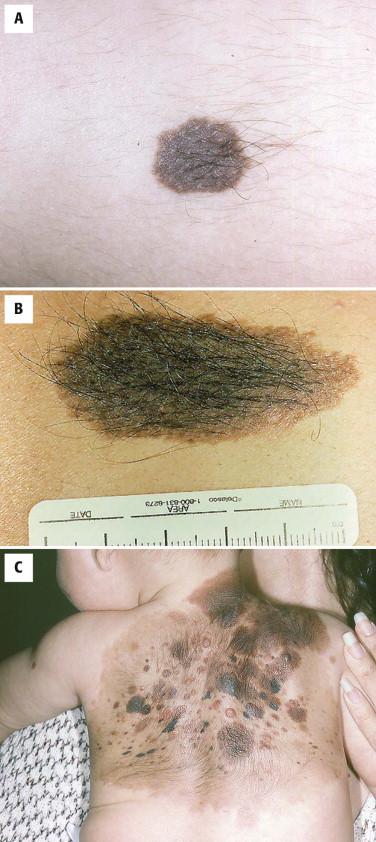
Congenital melanocytic nevi may or may not have a papillomatous epidermal silhouette. Their superficial portion is similar to acquired nevi. However, congenital nevi typically show infiltration of melanocytes into the reticular dermis ( Fig. 12-30 ). Melanocytes may even be present in the subcutis or deep soft tissues in a perivascular or interstitial distribution. In congenital nevi, melanocytes are more often seen involving adnexal structures (eccrine ducts, folliculosebaceous units) than in acquired nevi. Involvement of smooth muscle and peripheral nerve trunks may also be found. In some congenital nevi, melanocytes are present in the walls of blood vessels. Large congenital nevi may show prominent schwannian or neurofibromatous features and contain heterologous elements such as cartilage.
Present at birth or clinically apparent in early childhood
May be large (giant nevi)
Silhouette
Symmetric
Sharp peripheral borders
Junctional component
Similar to common nevi but may be broader
Possible associated papillomatous epidermal hyperplasia
Possible pagetoid melanocytes
Stromal component
Evidence of maturation
Frequently involves reticular dermis, may extend into subcutis
Patterns of dermal involvement: diffuse, interstitial, or perivascular
Adnexal involvement is common
Nerve involvement may be seen
Schwannian differentiation may be prominent
Cellular or proliferative nodules may be present
Heterologous elements may be present in large nevi
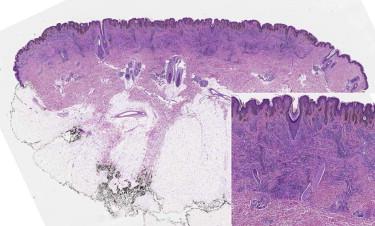
Cellular or proliferative nodules may develop in congenital nevi, especially giant congenital nevi. They manifest as areas of high cellular density that typically blend with the surrounding nevus component. Mitotic figures may be present (proliferative nodule). The melanocytes in these nodules may be fusiform or epithelioid. Cellular spindle cell nodules may have a primitive mesenchymal or sarcomatoid appearance. They may not be uniformly immunoreactive for melanocyte differentiation antigens or even S100 protein.
On exceedingly rare occasions, sarcomatoid nodules with histologic and immunohistochemical features indistinguishable from a sarcoma, such as a rhabdomyosarcoma, may arise in a giant congenital nevus.
The distinction of congenital nevi from acquired nevi is best made clinically. Although large and deep congenital nevi are histologically distinctive, many features associated with small congenital nevi may also be seen in acquired nevi. Confusion with in situ melanoma is possible because benign pagetoid melanocytes may be found in congenital nevi. Attention to clinical and histologic context (young age; nevus with otherwise benign features, including cytologically bland melanocytes with evidence of maturation) is needed to avoid a diagnostic error. In situ melanoma is best recognized by the presence of cytologically atypical pagetoid melanocytes and asymmetric extension of such cells peripherally beyond the dermal nevus component.
With regard to the dermal or subcutaneous component, congenital nevi may contain areas of high cellular density without (cellular nodules) or with mitotically active melanocytes (proliferative nodules) that need to be distinguished from melanoma ( Fig. 12-31 ). Characteristically, melanoma displays a sharp demarcation between its cytologically atypical cells and the adjacent bland nevus cell population ( Fig. 12-32 ). In contrast, cellular or proliferative nodules tend to mature and blend with the surrounding nevus cells. Cellular or proliferative nodules are usually composed of epithelioid melanocytes, but some nodules are almost exclusively composed of fusiform melanocytes.
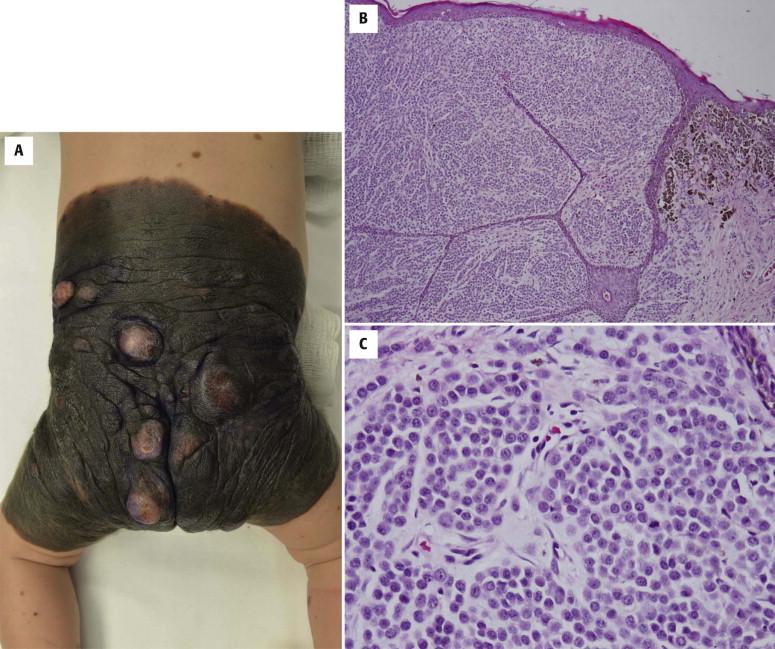
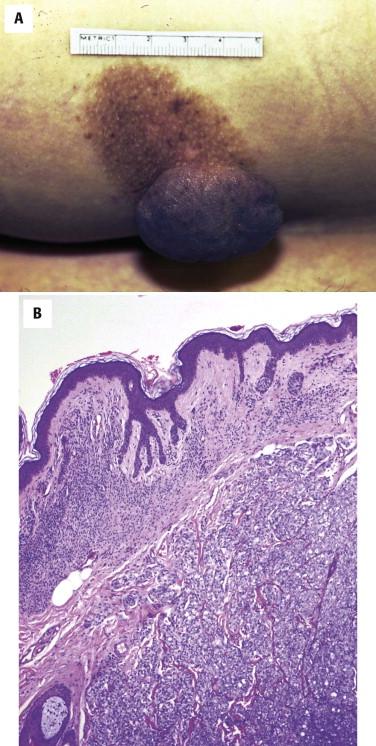
When congenital nevi show prominent differentiation along schwannian lines and contain heterologous elements, they may also be referred to as neurocristic hamartoma . However, the latter term has generated some confusion because it has been used in the literature for a spectrum of melanocytic proliferations, including large blue nevi, combined nevi, neurotized nevi, and congenital nevi with and without heterologous elements.
Cytogenetic analysis may be helpful for the distinction of cellular or proliferative nodules from malignant melanoma. Benign proliferations in congenital nevi either lack chromosomal copy number changes or display whole chromosome gains, in contrast to malignant melanomas, which tend to display a mix of gains and losses at several chromosomes.
Blue nevi comprise a spectrum of melanocytic lesions characterized clinically by a bluish appearance ( Fig. 12-33 ). A blue nevus (BN) may be present at birth or appear later in life. Preferred locations are the head and neck region, buttock, and dorsum of the wrist or foot. Most BNs are small and circumscribed lesions (see Fig. 12-33 ). However, unusual clinical variants exist, which may clinically present as large nodules (cellular BN) or plaques (plaque type BN) ( Fig. 12-34 ) or as targetoid lesions (targetoid BN). Extracutaneous occurrence has been reported at various sites, including conjunctival, oral, or sinonasal mucosa; the gastrointestinal or urogenital tract; and lymph nodes. Leptomeningeal melanocytosis or intracranial lesions reported as melanocytoma represent lesions in the spectrum of BN-like melanocytic proliferations.
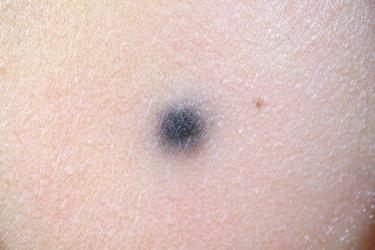
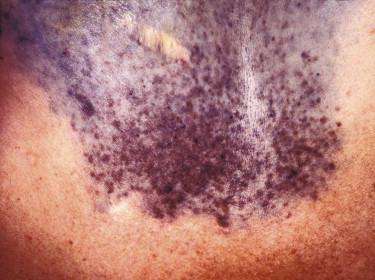
The related dermal melanocytoses usually manifest clinically early in childhood and tend to be flat lesions of brown-bluish discoloration. The Mongolian spot typically affects the lumbosacral region, the nevus of Ota (nevus fuscoceruleus ophthalmomaxillaris) involves the segment of skin innervated by the first and second branch of the trigeminal nerve, and the nevus of Ito (nevus fuscoceruleus acromiodeltoideus) is present on the shoulder or upper arm. Acquired and congenital variants of dermal melanocytoses exist, which may manifest with an unusual anatomic distribution.
Both BN and dermal melanocytosis are characterized by the presence of dendritic or fusiform melanocytes in the dermis or subcutis. Variable numbers of melanophages may be present. Except for combined or collision lesions, BNs lack a junctional melanocytic proliferation. In dermal melanocytoses, the melanocytes are dispersed as solitary units and separated from each other by abundant intervening stroma ( Fig. 12-35 ). BNs represent localized melanocytic proliferations ( Fig. 12-36 ), in which the lesional cells are more closely apposed to each other and may even form fascicles or nests. There is a spectrum of light microscopic appearances of lesions classified as BN. The typical “common” BN (see Fig. 12-36 ) is an intradermal proliferation of slender fusiform and dendritic pigmented melanocytes, which are often associated with melanophages and variable degrees of dermal fibrosis. Commonly, they are found in association with a hair follicle. Variations may be seen with regard to size ( Figs. 12-37 to 12-42 ), intralesional stromal fibrosis, pigmentation, cellularity, cellular composition (presence of another nevus-type component), cytology (e.g., epithelioid versus spindle versus dendritic cells), and growth patterns. Accordingly, a number of subtypes of BN have been proposed that reflect this spectrum (e.g., sclerosing BN, hypo- or amelanotic BN, epithelioid BN [EBN], cellular BN). On rare occasions, a BN may be associated with a benign trichoblastic proliferation (similar phenomenon as with superficial trichoblastic proliferations and dermatofibromas). BN can also be found together with a tricholemmoma or smooth muscle hamartoma. BN may be large and present as diffuse dermal or subcutaneous pigmented plaque (plaque-type BN).
Bluish or gray to black appearance
Usually small papule
Common sites include dorsum of foot, wrist, and head
Usually oval-shaped lesion in reticular dermis
Composed of slender fusiform and dendritic melanocytes, usually heavily pigmented with associated melanophages
Stromal fibrosis is common
Periadnexal growth is common
Nerve involvement may be seen
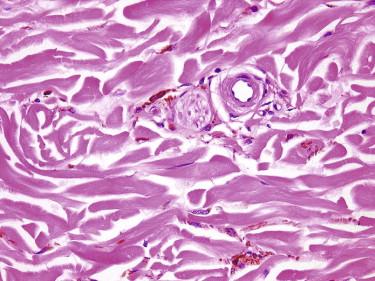
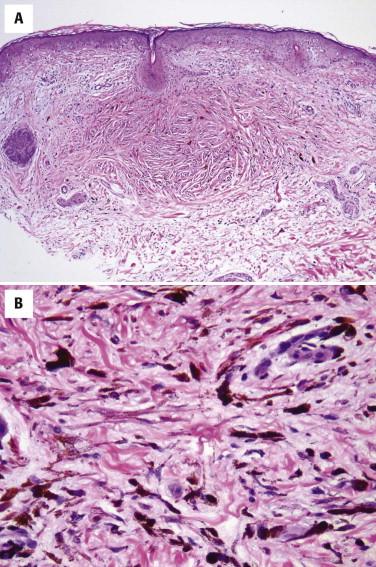
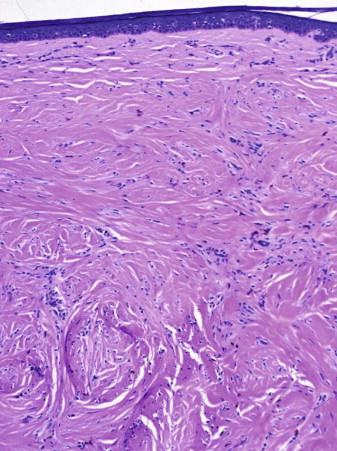
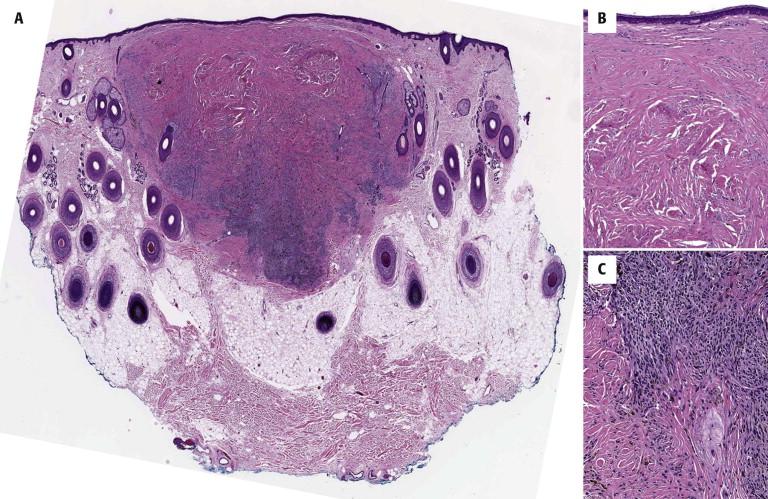
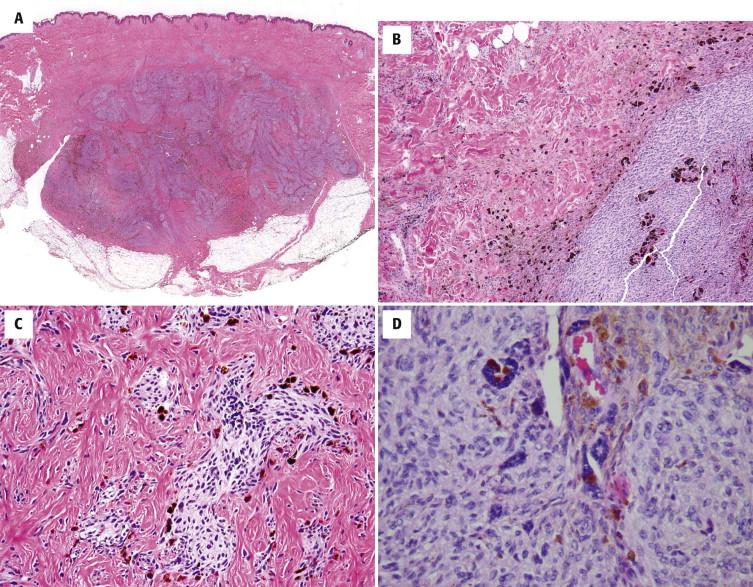
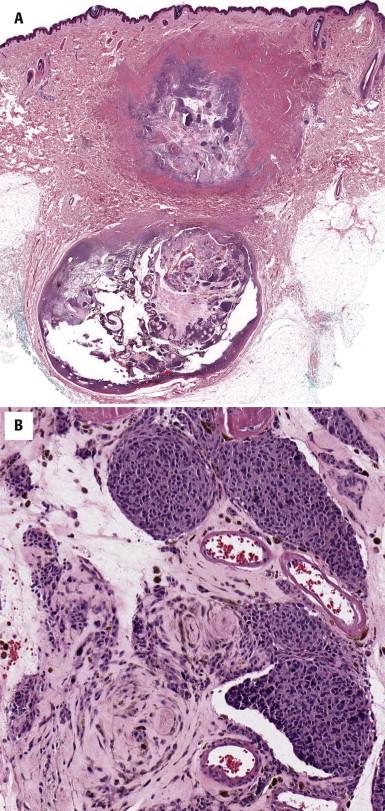
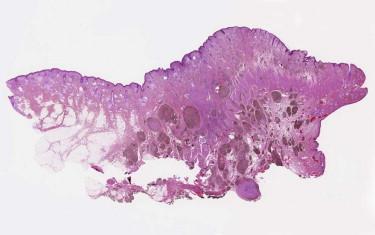
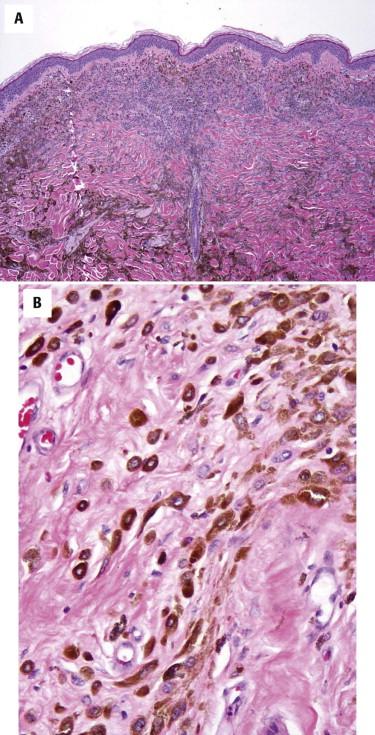
The sclerosing BN is characterized by prominent stromal fibrosis. It usually has an overall low cellular density ( Fig. 12-37 ). However, some larger lesions may display a combination of hypo- and hypercellular areas ( Fig. 12-38 ). Hypo- or amelanotic BN lacks readily detectable melanin pigment and may be confused with a dermatofibroma. The classic cellular BN shows a circumscribed nodular growth pattern ( Fig. 12-39 ). Bulging tongue-like extensions of densely cellular sheets into the deep dermis or subcutis may be present. Often a biphasic pattern is seen, characterized by the presence of common BN-like areas juxtaposed with more densely cellular paucimelanotic or amelanotic nested or fascicular aggregates of melanocytes with pale cytoplasm (see Fig. 12-39 ). Cystic degeneration may occur in large lesions ( Fig. 12-40 ). Multinucleation of melanocytes in cellular blue nevi is a common finding.
Sacral region or buttock, foot, and scalp are most commonly affected
Onset usually in childhood
Well-circumscribed gray-blue nodule
Localized to reticular dermis
Nodular expansile growth patterns of cellular aggregates
Often bulging extensions seen at the base of the lesion
Biphasic pattern common with combinations of cellular nodules of spindle or epithelioid cells admixed with a background of features of common blue nevus (pigmented spindle and dendritic cells dispersed in a fibrous stroma with melanophages)
Alveolar pattern may be present (fascicles of spindle cells compartmentalized by fibrous strands)
Monophasic fascicular pattern
Melanoma of soft parts (clear cell sarcoma)
Primary cutaneous or metastatic melanoma
Nerve sheath tumor
The plaque-type BN broadly infiltrates dermis and often deeper soft tissue ( Fig. 12-41 ). It may have an appearance that except for the area of involvement and clinical size is indistinguishable from a common BN. However, not uncommonly, larger longstanding lesions contain variably cellular nodules.
The EBN is characterized by the predominance of epithelioid melanocytes ( Fig. 12-42 ). Their nuclei usually show an open chromatin pattern with or without a small distinct nucleolus.
On rare occasion, primary or metastatic melanoma may arise in association with or histologically mimic a BN, usually a cellular BN or EBN. Such primary tumors have historically been referred to as malignant blue nevus . The diagnosis of melanoma is straightforward if the histologic appearance is that of an obvious malignant tumor (necrosis, atypia, mitoses, infiltrative growth), but it can be difficult when mitoses are rare and the degree of atypia is low. Monophasic cellular blue nevi may be large and densely cellular with fascicles of spindle cells lacking a nested growth pattern. Attention to the presence of aggregates or sheets of atypical epithelioid melanocytes with mitotic figures is important to recognize melanoma arising in a cellular BN. Monophasic amelanotic variants of cellular BN may be confused with a sarcoma, such as synovial sarcoma or clear cell sarcoma. Melanoma may be suspected if there is a large expansile area of fascicular (sarcomatoid) overgrowth.
Melanoma metastatic to skin may have a BN-like clinical and histologic appearance. For such metastasis, clinical context is essential. Most BN-like melanoma metastases occur in the setting of a known prior cutaneous or ocular melanoma. Histologically, such lesions usually contain atypical epithelioid melanocytes with at least a rare mitotic figure.
The discussion of the differential diagnosis of EBN needs to address the term pigmented epithelioid melanocytoma, a proposed provisional diagnostic entity for an EBN-like heavily pigmented melanocytic tumor of alleged low-grade malignant potential. In our experience, reported cases of pigmented epithelioid melanocytoma (PEM) seem to represent a spectrum of melanocytic tumors ranging from EBN, melanophage-rich BN, BN-like benign “borderline” melanocytic tumors, and rarely pigmented melanophage-rich or BN-like epithelioid melanomas. A lesion that was reported by several pathologists as PEM is illustrated in Fig. 12-43 . Although the term PEM allows one to deal with diagnostically challenging pigmented melanocytic tumors, for which a reliable distinction between melanoma and an unusual pigmented nevus is difficult or impossible by light microscopic examination alone, we caution against labeling lesions as PEM, which previously would have been diagnosed as benign EBN or pigmented dermal spindle and epithelioid cell nevus. Additional confusion about the biologic potential of the PEM comes from reports that pigmented melanocytes and melanophages may be found in the sentinel nodes draining such lesions. Such findings are not proof of malignancy; similar features can be observed with nodal BN or deep penetrating nevi.
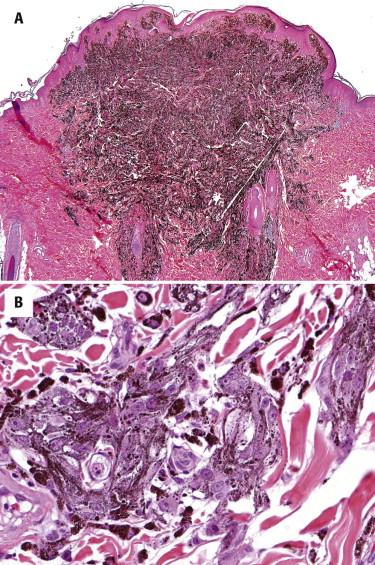
Ancillary cytogenetic studies can be helpful for the distinction of BN from BN-like primary or metastatic melanoma. Copy number changes are commonly found in melanomas arising in association with BN. Mutation analysis for GNA11 or GNAQ (commonly positive in blue nevi) may also assist in distinguishing BN from other pigmented melanocytic or soft tissue tumors.
The spectrum of histologic features of melanocytic nevi depends to some degree on anatomic site. Knowledge of the spectrum of site-dependent features is important when one weighs the significance of various findings for the final diagnosis.
Nevi at flexural sites, including the axilla, umbilicus, and groin, for example, may have large nests or great variation in the size and shape of nests ( Fig. 12-44 ). Cellular dyscohesion of nevomelanocytes may be seen. Often there is a complex pattern of associated epidermal hyperplasia. Similar features may also be present in nevi of the genital region, where nests may greatly vary in size and shape and display complex growth patterns. Additional complexity and diagnostic confusion may be related to superimposed inflammatory or fibrosing changes from conditions, such as lichen sclerosus. Likewise, nevi of the ear may show a complex growth pattern and associated features secondary to irritation.
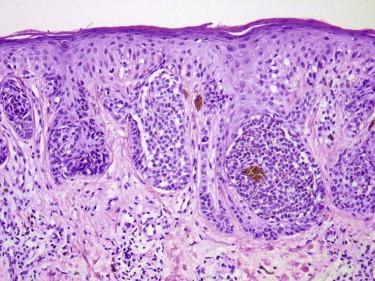
Nevi at acral sites, especially on the palms and soles, may show discrete columns of melanin pigment in the stratum corneum ( Fig. 12-45 ). There may be ascent of cytologically bland melanocytes as solitary units of nests into the mid and upper epidermis. Thus, pagetoid spread of melanocytes (pagetoid melanocytosis) per se is not sufficient for a diagnosis of melanoma in situ at an acral site if the lesion otherwise shows features of a benign nevus. In acral nevi, melanocytes may be dispersed prominently along eccrine ducts.
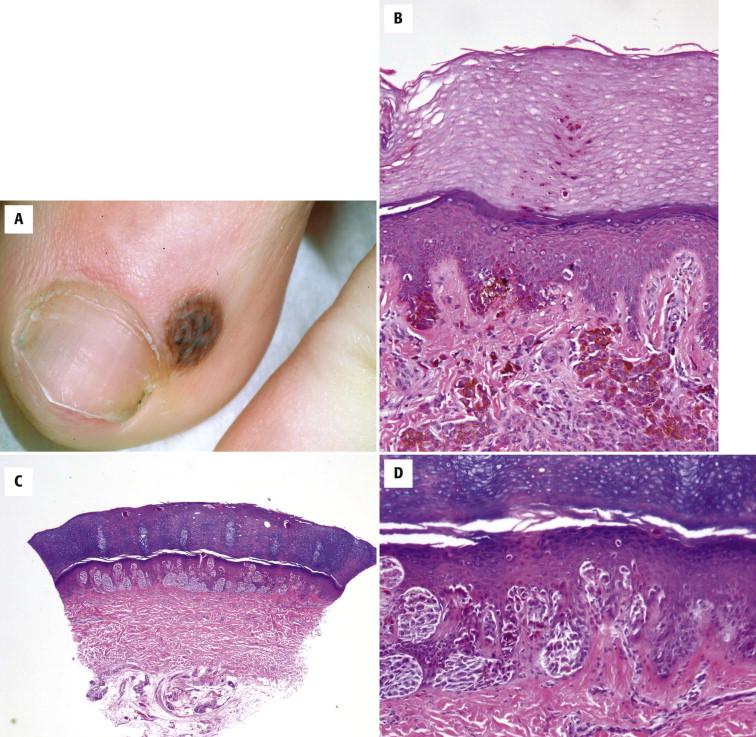
The nevus spilus or speckled lentiginous nevus is a lightly pigmented macular lesion (ranging from less than 1 cm to greater than 20 cm in size) that contains dark speckles ( Fig. 12-46, A ) that may be flat or raised. It may be present at birth but more commonly develops in childhood, with a predilection for the trunk and extremities.
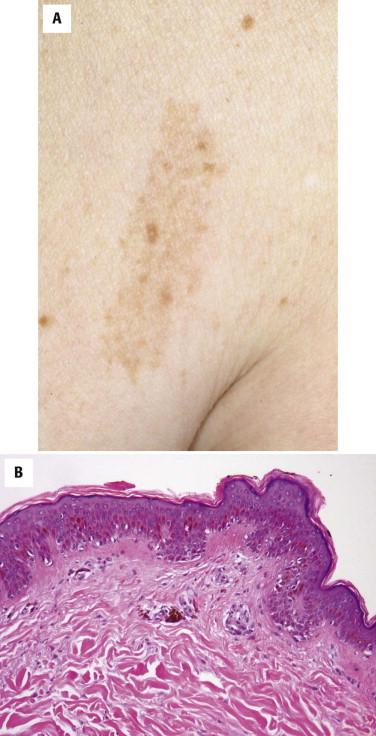
The tan macular component is histologically characterized by basal layer hyperpigmentation, often accompanied by a slight increase in the density of solitary melanocytes (similar to a lentigo). The histologic correlate of the clinically darker speckles may be that of a lentigo simplex, lentiginous junctional ( Fig. 12-46, B ), compound, or intradermal melanocytic nevus. Various histologic types of nevi may be represented within the dark spots of speckled nevi.
Additional types of melanocytic nevi have been described, which are uncommon. Three such types are briefly presented here: the so-called deep penetrating nevus (DPN), plexiform spindle cell nevus, and the desmoplastic nevus.
In its classic manifestation the DPN is a dome-shaped papule with various shades of color. Histologically, it is characterized by a wedge-shaped silhouette ( Fig. 12-47 ). It often extends into the deep dermis and may involve the subcutis. The melanocytes of a DPN may be large and epithelioid or fusiform in appearance. They are often pigmented. Melanophages are present in variable numbers. Lesional melanocytes are often displayed in a plexiform growth pattern. Some pathologists prefer to designate such nevi as plexiform spindle and epithelioid cell nevi. Published definitions of DPN are not precise and suggest overlap with variants of BN, pigmented Spitz's nevi, and even melanoma. One should hesitate to make a diagnosis of atypical DPN. We have seen melanocytic proliferations designated as DPN by experienced pathologists, which were followed by the development of metastatic melanoma. Those cases were notable for the presence of large epithelioid melanocytes with mitotic figures.
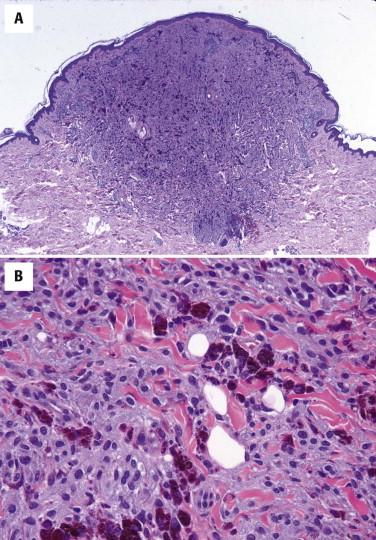
Become a Clinical Tree membership for Full access and enjoy Unlimited articles
If you are a member. Log in here